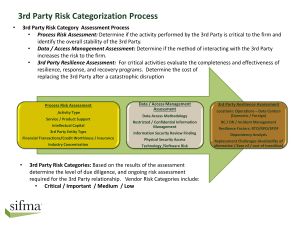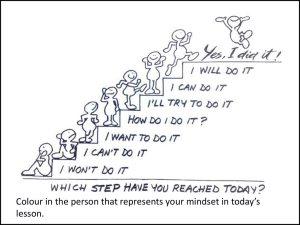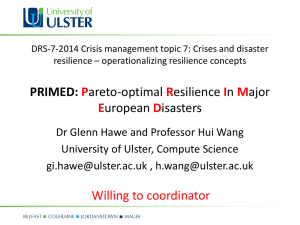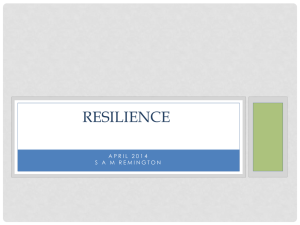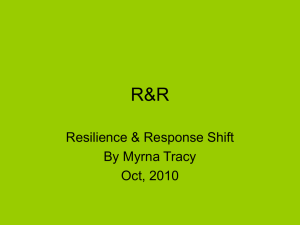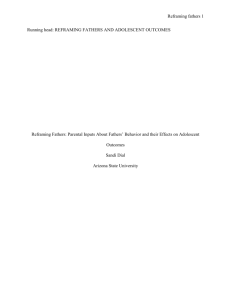Click - Udayan Care
advertisement
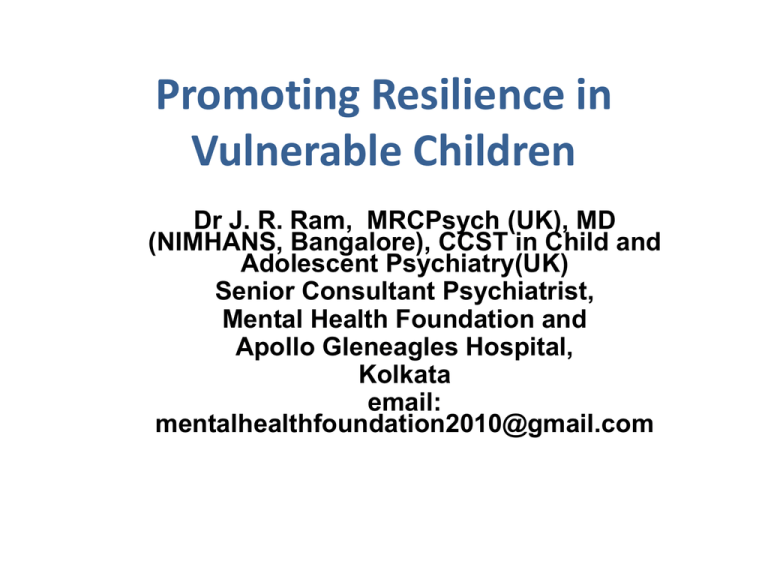
Promoting Resilience in Vulnerable Children Dr J. R. Ram, MRCPsych (UK), MD (NIMHANS, Bangalore), CCST in Child and Adolescent Psychiatry(UK) Senior Consultant Psychiatrist, Mental Health Foundation and Apollo Gleneagles Hospital, Kolkata email: mentalhealthfoundation2010@gmail.com What is Resilience? • Resilience has been defined as the ability to “bounce back” when things go badly for us. Resilience helps people carry on, even when they meet difficulties on their path • Research shows that children can learn to be more resilient. • They benefit from having people around them who believes in their ability to succeed. • Research crucially shows that RELATIONSHIPS BUILD RESILIENCE • HENCE YOU ARE IMPORTANT • Your job is to think Resilience as clusters of strengths that are mobilised in our struggle with hardships • YOUR AIM IS TO DEVELOP THOSE STRENGTHS/SKILLS • They can learn the attitudes and skills that will help them “bounce back” from negative experiences. • It is not a static trait What Are Those Skills? • • • • • Self-Confidence Emotional Awareness and Control Flexibility Empathy Accurate thinking • Taken together, these are important factors in helping children become good problem solvers, a key to being able to meet challenges WHAT ARE THE TECHNIQUES • ROLE PLAY/REHEARSALS • GROUP DISCUSSION • FOSTERING BONDS AND KINSHIP/BUDDY SYSTEMS • MODELLING • REFRAMING • HELPING YP TO THINK OF ADVERSITIES AS A PARADOX REFRAMING • Reframing is a technique that originated in the field of family therapy . • Reframing is based on the observation that we all have stories about ourselves. The organizing themes of some people's stories can be constructive OR destructive. • The technique of reframing capitalizes on the subjective nature of personal stories to uncover underlying, underemphasized themes in people's stories that are potentially helpful. • The purpose of Reframing is to arrive at an authentic and helpful story, one that does not eliminate the pain, that hardship can cause, but that also includes the strength that is forged in the struggle to prevail. • Did Krishna reframe the war and meaning of life for Arjun? EXAMPLE • For instance, a YP can think, "I am shrewd. I've am developing the ability to watch out for myself against the bullies. I have used those skills to escape the worst of the abuse and tomorrow the same skills will help me to be a strong person.“ This is a constructive story • Other stories can be destructive. They cause considerable pain and get in the way of a productive life, for instance, "I am helpless as a child. I am a victim of the bullies’ abuse . They have damaged me and made me realise that I can't do anything right or ever trust anyone again." The Concept of Resilience as a Paradox • You have defined resilience as the process of persisting in the face of adversity. • You see evidence of resilience in the small details of YP’s lives as they try to deal constructively with the daily challenges that hardship brings. • This concept encompasses both the psychological damage and the enduring strength that can result from struggling with hardship. • SO, YOU AS THE PRACTIONER, have to believe in the paradoxical definition of resilience as it will inspire you to search for and find strength even in the most vulnerable YP. • It is a definition that encourages respect and optimism which can "rub off" on YP and be a starting point for constructive change.



